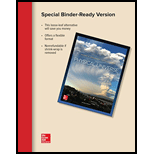
Concept explainers
The most abundant element in the earth’s crust is
- a. oxygen
- b. nitrogen
- c. silicon
- d. carbon
The most abundant element in the Earth’s crust.
Answer to Problem 1MC
Option-(a)-“Oxygen”
Explanation of Solution
The outer part of the Earth is called the crust is almost composed of rock. Earth’s crust consists of a very few abundant elements. Most of the elements are present in minor amounts.
Conclusion:
Oxygen is the most abundant element of the Earth’s crust, which is of about 46.6% of the total mass of the Earth’s crust. Silicon stands at the second place, which has about 27.7% of mass; whereas calcium is 3.6%, sodium is 2.8%, potassium is 2.6%, and magnesium is 2.1%. All the other elements occupy the remaining portion. Hence, option (a) is correct.
As silicon, nitrogen, and carbon occupy a less percentage of mass than oxygen, options (b), (c), and (d) are incorrect.
Want to see more full solutions like this?
Chapter 15 Solutions
Loose Leaf For The Physical Universe
- How does sedimentary rock from the ocean floor sometimes end up in highland and mountainous regions on the Earth? (22.5) (a) Sedimentary rock is commonly made inside volcanoes. (b) Wind and water carry the sediment to the mountaintops. (c) It is believed that asteroid impacts probably caused the sedimentary rock to move great distances. (d) The sedimentary rock was uplifted by powerful forces to form mountain chains.arrow_forwardChemical weathering can be determined by analyzing what property of a rock? (23.1) (a) temperature (b) density (c) composition (d) massarrow_forwardWhat is the process of transforming sediment into sedimentary rock called?(22.5) (a) lithification (b) striation (c) metamorphism (d) hardeningarrow_forward
- You are given five transparent objects: a calcite crystal, a diamond, a piece of window glass, a sample of quartz, and a piece of zircon. How would you go about identifying each sample? How would they rank on the Mohs hardness scale?arrow_forwardDescribe each of the following and state whether it is a fast or a slow type of mass wasting: (a) rockslide, (b) creep, and (c) slump.arrow_forwardThe sedimentary rock called shale metamorphoses into the rock called ___. (22.6)arrow_forward
- Review. The North American and European plates of the Earths crust are drifting apart with a relative speed of about 25 mm/yr. Take the speed as constant and find when the rift between them started to open, to reach a current width of 2.9 103 mi.arrow_forwardThe simple, common method of classifying minerals depends on which general property? (22.1) (a) physical (b) chemical (c) nuclear (d) opticalarrow_forward
 An Introduction to Physical SciencePhysicsISBN:9781305079137Author:James Shipman, Jerry D. Wilson, Charles A. Higgins, Omar TorresPublisher:Cengage Learning
An Introduction to Physical SciencePhysicsISBN:9781305079137Author:James Shipman, Jerry D. Wilson, Charles A. Higgins, Omar TorresPublisher:Cengage Learning Physics for Scientists and Engineers, Technology ...PhysicsISBN:9781305116399Author:Raymond A. Serway, John W. JewettPublisher:Cengage Learning
Physics for Scientists and Engineers, Technology ...PhysicsISBN:9781305116399Author:Raymond A. Serway, John W. JewettPublisher:Cengage Learning

